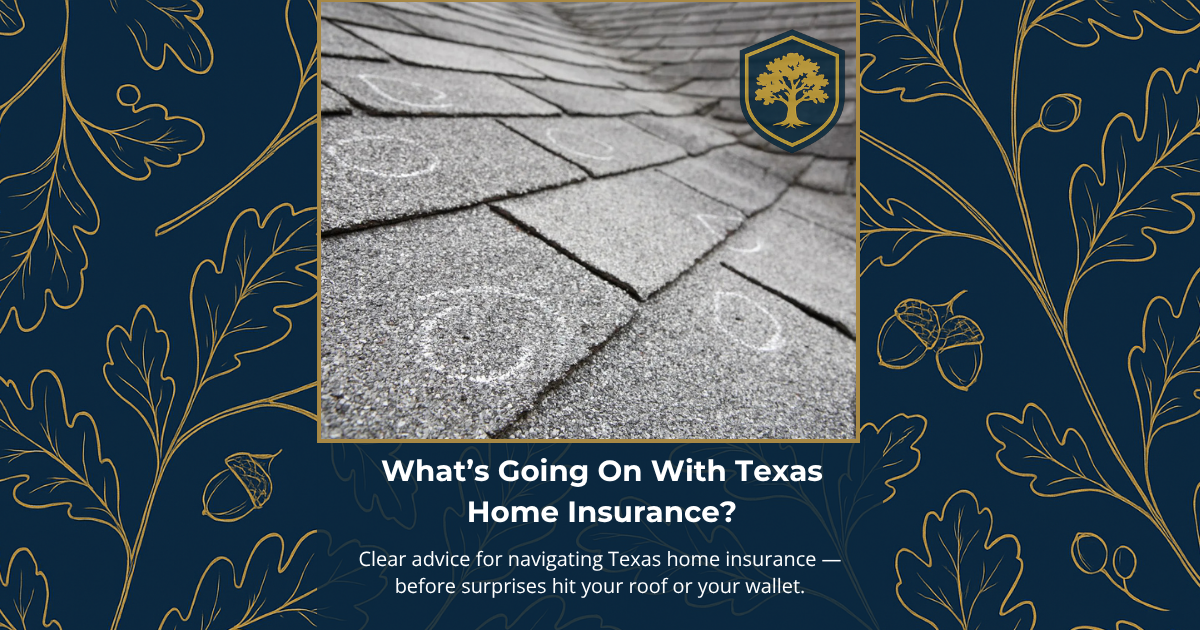What’s Going On With Texas Home Insurance?
If you’ve opened your renewal notice lately and felt your jaw drop — you’re not alone.
Texas home insurance rates have surged across the state, leaving many homeowners wondering what changed, and why their once-stable premiums have jumped hundreds or even thousands of dollars a year.
Let’s unpack what’s really driving these increases, why some carriers are tightening their coverage, and how you can make sure you’re not left with costly surprises when the next storm hits.
Why Are Texas Home Insurance Rates Rising?
There’s no single culprit — it’s a perfect storm.
Texas experiences more severe weather than almost any other state. Hail, tornadoes, hurricanes, and wind damage combine to make it one of the costliest states for property insurers.
Add inflation, labor shortages, and higher material costs for roofing and construction — and the result is a wave of rising home insurance rates that show no sign of slowing.
Behind the scenes, carriers also pay more for reinsurance — that’s “insurance for insurance companies.” When global reinsurers raise their prices due to storm losses, those costs trickle down to homeowners.
For many Texans, that means annual premiums climbing 20–40% or more, even without filing a single claim.
Learn more about Texas Home Insurance: Texas Department of Insurance – Homeowners Insurance Guide
Why Some Carriers Are Leaving the State (or Reducing Coverage)
As storm losses pile up, several insurers have decided to pause writing new home policies in Texas or limit coverage in high-risk ZIP codes. Others are quietly adjusting how they handle roof claims — and this is where things get tricky.
Instead of paying full replacement cost for roof damage, more companies are offering roof payment schedule coverage, sometimes called actual cash value (ACV) or “depreciated roof” policies.
That means they only reimburse you for what your roof is worth at the time of loss — not what it costs to replace it.
Example: If your 10-year-old roof costs $20,000 to replace but is valued at 50% due to age, your payout may only be $10,000 — before your deductible is even applied.
Yes, these policies come with lower premiums, but that “savings” could cost you tens of thousands when it matters most.
Understanding Roof Deductibles — and Why 2% is the New Normal
In the past, many homeowners carried a 1% deductible for wind and hail claims. Today, most carriers have moved to 2% roof deductibles — meaning you’re responsible for 2% of your dwelling coverage amount before insurance kicks in.
Example: On a $400,000 home, a 2% deductible equals $8,000 out of pocket.
That’s a big check to write after a storm.
The good news? Not all carriers have abandoned 1% options. Allstate still offers 1% deductibles for qualified homes — and, just as importantly, maintains full replacement cost coverage for roofs.
So while you might pay a little more in premium, you could avoid a massive financial hit after hail or wind damage.
Read about better ways to save: 7 Smart Reasons to Bundle Home and Auto Insurance in Texas
Roof Payment Schedule Coverage — The Hidden Cost of “Cheaper” Insurance
It’s easy to focus on price when shopping for insurance — but cheaper doesn’t always mean better.
With roof payment schedule coverage, your insurer depreciates your roof’s value over time. The older your roof, the smaller your payout.
This means even if your home is insured for its full value, your roof might not be.
For example: A homeowner with a 15-year-old roof and a roof payment schedule could receive less than $5,000 on a $20,000 replacement — even before their deductible.
That’s a tough lesson to learn after a storm, especially for families who thought they had “full coverage.”
Full replacement cost (RCV) coverage policies — like those still offered by Allstate — cover the total cost to replace your roof after damage, minus your deductible. No depreciation. No surprises.
Learn more about RCV or ACV Roof Coverage: Insurance and your roof: What to know when buying a policy or filing a claim
Why a Homeowners Policy Review Could Save You Thousands
If it’s been more than a year since someone reviewed your policy, now’s the time.
Home insurance isn’t set-it-and-forget-it — and with all the recent changes in the Texas market, it’s critical to know exactly what you’re paying for.
A licensed local agent can:
✅ Identify coverage downgrades hidden in your renewal
✅ Check whether your roof coverage changed to a schedule or ACV
✅ Review your deductibles and compare 1% vs 2% options
✅ Find carriers that still offer replacement cost coverage
“It pays to have a professional review your coverage now — before you find out the hard way what isn’t covered.”
Read more about Homeowners Insurance: Texas Home Insurance Information & Resources | Gilded Oak Insurance
Final Thoughts — Don’t Wait for the Next Storm
The Texas home insurance market is changing fast — and the gap between “cheap” coverage and good coverage has never been wider.
Before the next hailstorm or hurricane season, take time to review your policy, ask questions, and make sure your roof and home are truly protected.
Because when a storm hits, the only thing worse than roof damage is realizing your coverage isn’t what you thought it was.
🏡 Need Help Reviewing Your Policy?
Our licensed Texas agents can walk you through your options, explain your roof coverage, and help you compare carriers side by side.
👉 Connect with a Texas Insurance Agent Today.
⚜️ Stay Connected with Gilded Oak
Join us on social for insurance savings tips, light-hearted entertainment, and everyday insights that make coverage easier (and a little more fun) to understand.
Request a Quote


